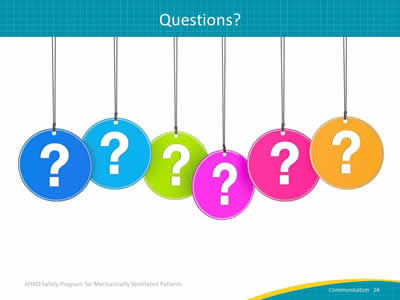Communication Strategies for Sustainability: Facilitator Guide
AHRQ Safety Program for Mechanically Ventilated Patients
Slide 1: Communication Strategies for Sustainability
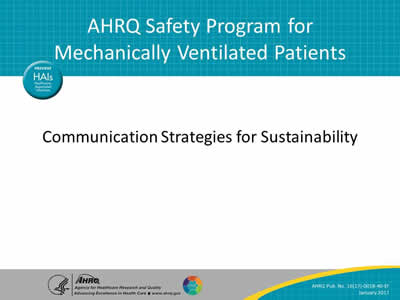
Say:
In this slide set, you’ll learn about communication strategies to sustain your safety program work.
Slide 2: Learning Objectives

Say:
After reviewing this module, you will be able to–
- Identify your target audience.
- Overcome the curse of knowledge.
- Articulate the goal of your message.
- Apply practical strategies to improve the effectiveness of team communications.
Share what you have learned with your teams.
Slide 3: AHRQ Safety Program For Mechanically Ventilated Patients
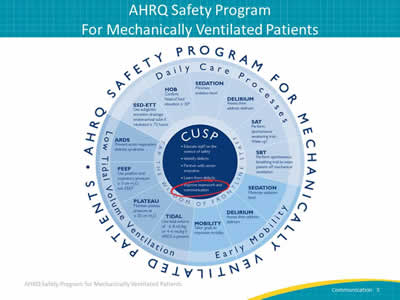
Say:
Today we will discuss strategies to improve communication to sustain your safety program efforts. Improve communication is the fifth step of the Comprehensive Unit-based Safety Program, also called CUSP.
Slide 4: Using Communication Strategies
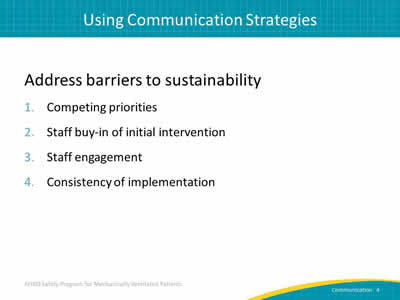
Say:
Barriers to long-term sustainability stem from competing priorities, lack of staff buy-in of the intervention, staff engagement, and the consistency of initial implementation efforts. The key to addressing complex barriers to sustaining your quality improvement efforts often lies in communication.
Slide 5: Sustaining Your Efforts
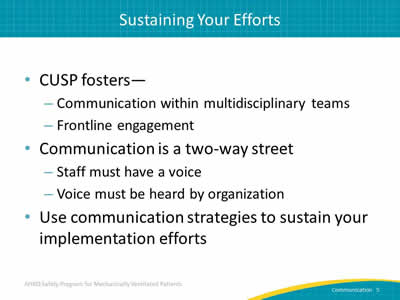
Say:
CUSP fosters communication by opening up forums for multidisciplinary team members to voice concerns and explore how their workflow relates to other groups. The CUSP process is a direct avenue to increase frontline engagement in quality improvement work.
Remember that effective communication is a two-way street. Staff must have a voice, and that voice must be heard by the organization. CUSP provides tools and a mechanism to sustain our implementation efforts over time.
Slide 6: Your Target Audience
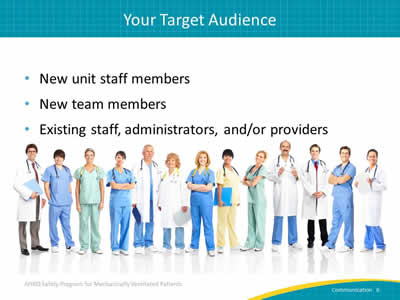
Say:
The first step and the most important part of EVERY communication effort is to identify your audience.
Ask:
Who are you talking to? New or existing staff? Internal or external audience? Nonclinical management?
Say:
Whether you are writing an email or updating your department, your audience should drive every decision you make regarding what you deliver and how you deliver it. Every communication is a conversation. Anticipate your reader’s questions and give them the information they need when they need it.
Slide 7: Your Target Audience
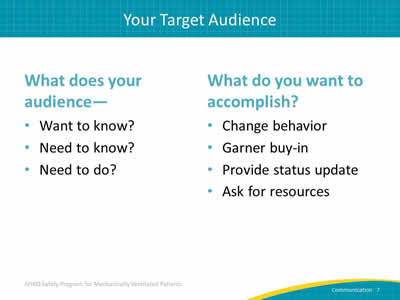
Say:
Once you know who you are talking with, clarify what your audience needs.
Ask:
What do they want to know?
What do they need to know?
What do they need to do?
Say:
Next, determine what you want to accomplish.
Ask:
Why are you sharing this information?
Say:
You may find it surprising that people who present information often aren’t even sure why the audience needs the information, or have unrealistic expectations for the audience’s understanding of the topic.
Ask:
Are you asking for protected time or new equipment? Do you need your staff to complete specific tasks?
Are you providing education and hoping your staff will agree with a new process?
Are you updating your department leadership?
Say:
Identifying what you are trying to accomplish is the first step toward achieving it.
Slide 8: What Does Your Audience Know?
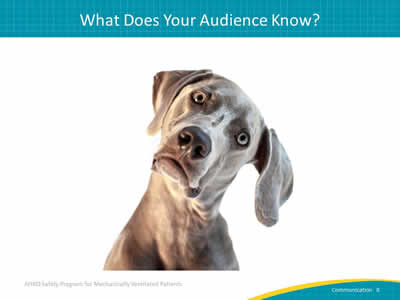
Ask:
What does your audience know?
Say:
Underestimate what you think your audience knows. Research consistently shows that we routinely believe people know more than they do.
Slide 9: Curse of Knowledge
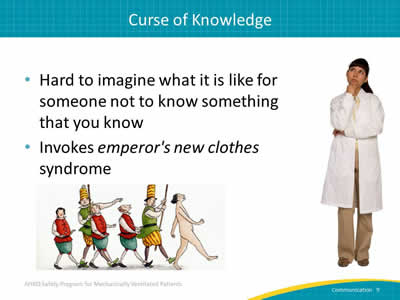
Say:
It’s hard to imagine what it’s like to not know something. If someone tells you the final score before you watch the game, you can’t enjoy the game the same way. We often overestimate what other people know, assuming they know what we know.
Ask:
Everyone has seen Star Wars, right?
Everyone knows why spontaneous awakening trials are important, right?
Say:
Not necessarily. And the more your audience thinks they should know, the less likely they are to ask.
Ask:
Remember the tale of two weavers who promise an emperor a new suit of clothes?
Say:
They said it was "invisible" to those who were unfit, stupid, or incompetent. When the emperor proudly parades around in his new clothes, no one dares to say that he doesn't see any suit of clothes. Neither the emperor nor the people wanted to appear inferior, until a child shouted, "But he isn't wearing anything at all!"
Your audience may not ask the questions to understand your message if they think they are already expected to know the information. Anticipate this hesitancy and be as direct, simple, and clear as possible. You want them thinking about your content, not deciphering what you mean.
Slide 10: Curse of Knowledge
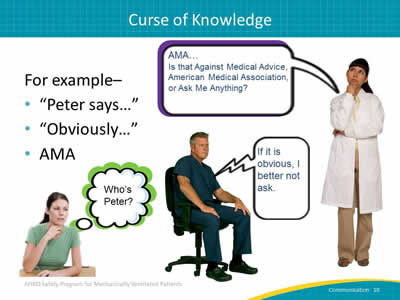
Ask:
Have you heard speakers reference people you don’t know?
What about when they feel the answer is obvious, but you aren’t sure what they are referencing?
How often do you hear or read acronyms without any context to explain what they mean?
Say:
You may have heard similar references.
For instance, the website Acronymfinder.com, a useful tool for looking up the meaning of an acronym, lists 21 different scientific and medical meanings for the acronym "AMA."
To ensure your audience knows what you mean, tell them. The people who do know won’t notice, and the people who don’t know will learn and be able to focus on your message, not be distracted trying to figure out what they missed.
Slide 11: Overcoming the Curse of Knowledge
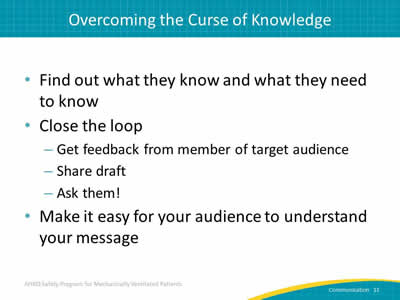
Say:
Check all assumptions.
You have likely been involved in this safety program for some time. By the sustainability phase, you know the evidence. Talking about the interventions is comfortable and possibly easy for you. But your comfort with the material is not necessarily true for every person on your unit. Different people will have varying levels of comfort or familiarity with every quality improvement initiative. Find out what they know and what they need to know. Get feedback from staff or share a draft. Ask for feedback, then incorporate that feedback into your communications.
These steps will ensure that you deliver what your audience needs. Make it easy for your audience to understand your message.
Slide 12: Overcoming the Curse of Knowledge
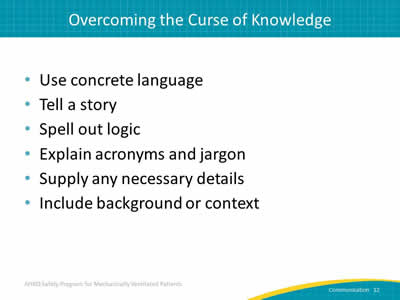
Say:
Many strategies can help break down the curse of knowledge and make your message resonate with your audience.
First, concrete language is easier to process and far more actionable than abstract concepts. For instance, focus on specific tasks of performing spontaneous breathing trials rather than general statements about the importance of weaning ventilator use.
Tell a story. When possible, tell a patient-centered story. Spell out your logic. Avoid leaps that may leave staff questioning the merits of your request. When you share the reasoning or evidence supporting your message, you begin to break down resistance and encourage a dialogue.
Explain acronyms and jargon. No one wants to feel uninformed. Use language that makes sense to your specific audience and explain any terms that may not be familiar. Supply any necessary details and background information to support your context.
Slide 13: Communicating With Your Team
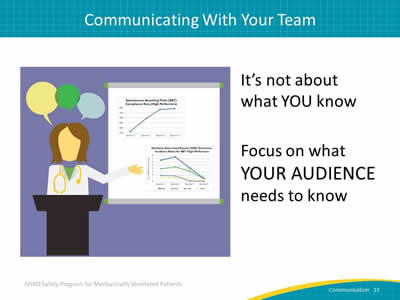
Say:
It’s not about what you know. You must focus on what your audience needs to know.
Slide 14: What Do You Want To Accomplish?
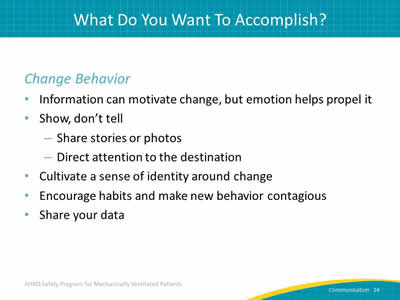
Ask:
So how do you do this?
Say:
Statistics can motivate people to change, but the emotions are often the force that propels people to act on their motivations. Share stories that make your message real or concrete. The journey to achieve a goal is hard. It is often more motivating to focus on the destination--that goal. Help your team envision what that success looks like.
Ask:
Since we know spontaneous awakening and breathing trials are proven to reduce time on mechanical ventilation, what if every patient every day received those treatments?
Say:
Quality improvement work is like a marathon that never ends. But find those finish lines along the way—compliance with process measures, a previously ventilated patient walking—that can motivate your staff and get them working towards the same goal.
Cultivate a sense of identity around change. Many years ago, Texas had a huge problem with litter. Government officials put up signs that said "No Littering" or "$200 Fine for Littering." But the trash problem grew.
After studying the roadsides, they determined that the biggest culprits were the "rough around the edges" "backwoods" guys driving pickup trucks; they didn’t care about "No Littering" signs or authority. Texas then developed the successful "Don’t Mess With Texas" campaign. It targeted people who cared about Texas to help keep it clean. They fostered a group identity that united residents and changed behavior.
Say:
For quality improvement work, this last step is critical.
Slide 15: What Do You Want To Accomplish?
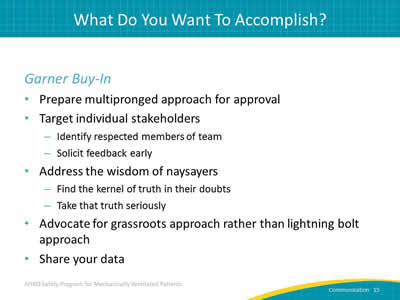
Say:
For change interventions to work, you must garner buy-in from the entire team responsible for implementing the changes. Leadership can make demands, but they don’t monitor every action every day. Your staff has to own the change.
Prepare a multipronged approach for approval. Target individual stakeholders that your staff respects and ask early for feedback. Address the wisdom of the staff members who resist the proposed change. These negative views are gifts, rather than inconveniences. Naysayers often have valid concerns that should be taken seriously.
Ask:
Would you rather address flaws during planning stages or after a failed implementation?
Say:
Take the opportunity to address concerns. This strategy also provides an excellent way to involve more stakeholders in your work. This safety program is based on a grassroots approach from the ground up rather than top down lightning bolt approach. Tap the wisdom of your frontline staff.
By this point in the project, you have data to share about your processes and your outcomes. Use it.
Slide 16: What Do You Want To Accomplish?
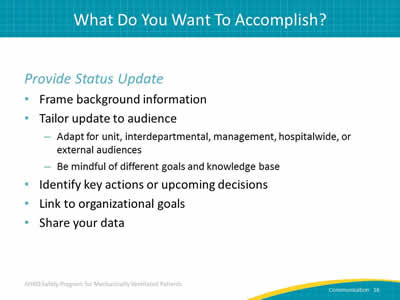
Say:
Earlier we discussed how easy it is to overestimate what staff know about your project. Be sure to provide some context to orient your audience to what you are sharing. Strong presentations (or emails) will have a beginning, a middle and an end. Your beginning can be a sentence or two reminding the group where you started or what your goal is, but that brief orienting information helps them understand and share your purpose.
Status updates can be boring. Hopefully, they are more boring for the speaker than for the listener. Try to include upcoming activities or a little mystery where appropriate. For example, "By next month, we will have implemented the new policy and expect to see some interesting results." or "This morning Mrs. Smith moved out of bed and to the chair. If all goes well, tomorrow our team will help her ambulate 20 feet. She may be the first ventilated patient in our unit to walk. I can update you on that progress next week."
When appropriate, link your safety program work to organizational goals. When updating department management or senior leadership, be sure to reference how this effort ties to current strategic priorities.
Finally, share your data. This step cannot be overstated.
Slide 17: What Do You Want To Accomplish?
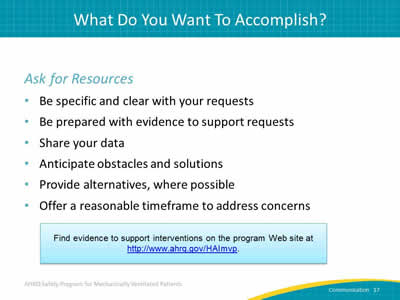
Say:
When asking for resources, be specific with what you want your audience to do. Share your data and the evidence to support your request.
Provide alternatives where appropriate. Spell out anticipated benefits of action and costs of not taking action. You may want 8 hours of protected time each week for data collection efforts. Rather than frame your request as all or nothing, provide intermediate options and what each option would offer. Be sure to offer a reasonable timeframe to address concerns.
Slide 18: Shorter Letter
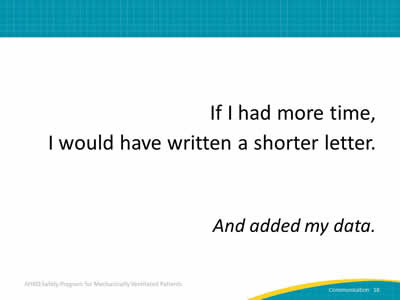
Say:
If I had more time, I would have written a shorter letter.
Woodrow Wilson was once asked about the amount of time he spent preparing speeches.
"That depends on the length of the speech," answered the President. "If it is a 10-minute speech it takes me all of 2 weeks to prepare it; if it is a half-hour speech it takes me a week; if I can talk as long as I want to, it requires no preparation at all. I am ready now."
Ask:
How many of you have attended an hour-long meeting that should have been a three-line email?
Or read an email that rambled on for pages, and you still didn’t know what the author wanted?
Say:
People are busy. People in health care are no exception. Make your point at the beginning–be clear and concise. Plan your communications so that your audience can quickly assess what you want from them. And use your data.
Slide 19: Practical Tips
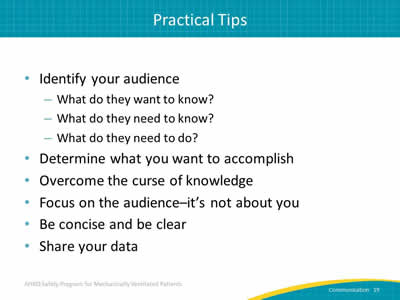
Ask:
Who are you talking to?
What does your audience need?
What do you want to accomplish?
Why are you talking, writing, or sharing?
Say:
Underestimate what your audience knows about your topic. They probably do not know as much as you think they do.
Focus on the audience. You are already the expert and standing in front. You don’t have to prove you deserve to be there.
Be concise and be clear. Do the work to make it clear so each member of your audience doesn’t have to do that work for themselves. Don’t make your audience work to figure out what you want them to do.
Ask:
And what is the recurring theme?
Say:
Share your data! By this point in the project, you have data to share about your processes and your outcomes. Use it.
Slide 20: Sample Generated Report
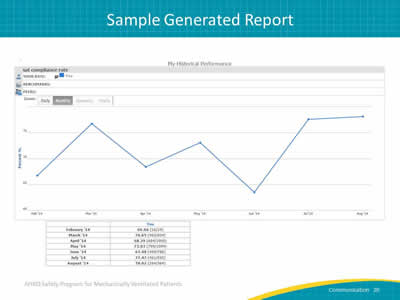
Say:
This is a sample of a report generated from hospital data. Regardless of the system your clinical area uses to report data, the output reports are often prepared for one audience and then recirculated for other uses.
Ask:
What does this sample graph tell you?
Say:
While the graph takes up full page, it is still difficult to understand. The title is hard to find, and I can’t read the axis labels.
Generated reports are great for quickly getting to the information you need. But when sharing that information with others less familiar with the report or when the stakes are high, you may need to customize that information so it is understood and easy to act on.
Let’s make a few improvements.
Slide 21: Monthly SAT Compliance Rate
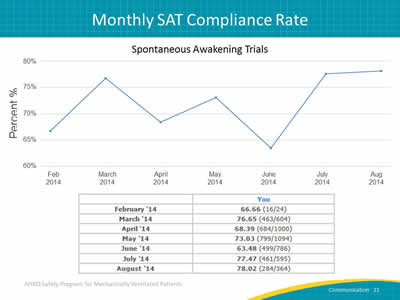
Say:
We can call this slide the "after" version. It is the same report, with a few modifications to make the information more accessible to the audience. We’ll walk through the improvements after you’ve had time to review.
Note: Show slides 20 and 21 again so the audience can evaluate the difference.
Slide 22: Monthly SAT Compliance Rate
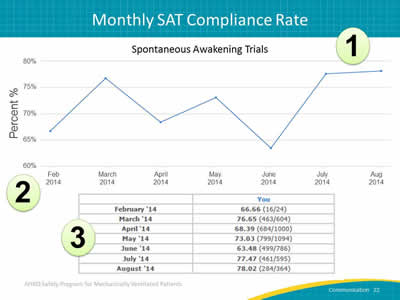
Say:
The numbers indicate where modifications were applied.
First, a legible title was added to explain the graph. It has a prominent position where a reader would expect to find the title. The acronym is defined, eliminating any doubt that a new reader would understand what data is being shared.
Second, new axis labels were added. To perform this task, a text box with a larger font size was added filled with white color. The white fill covers up the illegible program-generated text underneath.
Third, the image itself was duplicated, and each part was cropped differently. One image shows just the graph without the title information, while the other image shows just the numerator and denominator data. By separating these elements into two pieces, you can resize or relocate on the page to maximize readability.
For this example, the improvements took just a few minutes. The time spent before the presentation allows your audience to access the data far faster and process it. You may find you spend less time explaining the information and more time in a deeper discussion of what it means.
Slide 23: As SBT Compliance Rises, VAE Rates Plummet
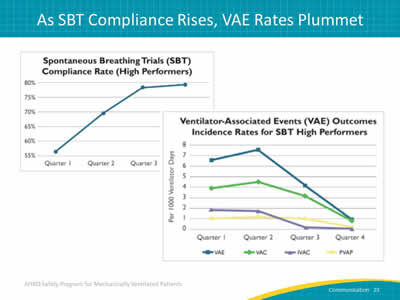
Say:
When possible, title your slides with the main takeaway from your data. In this example, compliance in a process measure contributes to improvements in outcome measures. The title conveys the main message, then the graphs support it. Notice that the acronyms are also clarified in the graph titles.
Slide 24: Questions?
